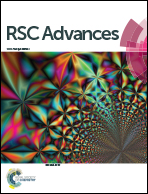Influence of anchoring group numbers in an efficient pyridine-anchor co-adsorbent of pyridinecarboxaldimine substituted aminonaphthalene on the performance of N719 sensitized solar cells†
Abstract
Unsymmetrical (N-(2-pyridinecarboxaldimine)-1-aminonaphthalene, USP) and symmetrical (N,N′-bis-(2-pyridinecarboxaldimine)-1,8-diaminonaphthalene, SDP) pyridine-anchor co-adsorbents with different numbers of anchoring groups are synthesized and employed in combination with a ruthenium complex N719 in dye sensitized solar cells (DSSCs). Both the prepared co-adsorbents can overcome the deficiency of N719 absorption in the low wavelength region of the visible spectrum, offset competitive visible light absorption of I3−, suppress the charge recombination and prolong the electron lifetime. The SDP co-adsorbent containing double anchoring groups shows better electronic coupling with TiO2 than the USP co-adsorbent with a single anchoring group. This enhanced electronic coupling leads SDP to exhibit better performance for DSSCs. A short circuit current density of 13.19 mA cm−2, an open circuit voltage of 0.75 V and a fill factor of 0.66 corresponding to an overall conversion efficiency of 6.51% under AM 1.5G solar irradiation are achieved when SDP is used as a co-adsorbent, which is much higher than that for DSSCs only sensitized by N719 (5.28%) under the same conditions.


 Please wait while we load your content...
Please wait while we load your content...